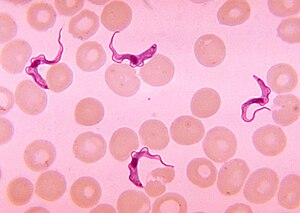African sleeping sickness
| African trypanosomiasis | |
|---|---|
| Synonyms | African sleeping sickness |
 |
|
| Specialty | Infectious disease |
| Symptoms | fevers, headaches, itchiness, joint pains |
| Usual onset | 1–3 weeks post exposure |
| Causes | Trypanosoma brucei spread by tsetse flies |
| Diagnostic method | blood smear, lumbar puncture |
| Medication | pentamidine, suramin, eflornithine |
| Frequency | 11,000 |
| Deaths | 3,500 |
| Classification | |
|---|---|
| External resources |
African trypanosomiasis, also known as sleeping sickness, is an insect-borne parasitic disease of humans and other animals. It is caused by protozoa of the species Trypanosoma brucei. There are two types that infect humans, Trypanosoma brucei gambiense (TbG) and Trypanosoma brucei rhodesiense (TbR). TbG causes over 98% of reported cases. Both are usually transmitted by the bite of an infected tsetse fly and are most common in rural areas.
Initially, in the first stage of the disease, there are fevers, headaches, itchiness, and joint pains. This begins one to three weeks after the bite. Weeks to months later the second stage begins with confusion, poor coordination, numbness and trouble sleeping. Diagnosis is via finding the parasite in a blood smear or in the fluid of a lymph node. A lumbar puncture is often needed to tell the difference between first and second stage disease.
Prevention of severe disease involves screening the population at risk with blood tests for TbG. Treatment is easier when the disease is detected early and before neurological symptoms occur. Treatment of the first stage is with the medications pentamidine or suramin. Treatment of the second stage involves: eflornithine or a combination of nifurtimox and eflornithine for TbG. While melarsoprol works for both stages, it is typically only used for TbR, due to serious side effects. Without treatment it typically results in death.
The disease occurs regularly in some regions of sub-Saharan Africa with the population at risk being about 70 million in 36 countries. An estimated 11,000 people are currently infected with 2,800 new infections in 2015. In 2015 it caused around 3,500 deaths, down from 34,000 in 1990. More than 80% of these cases are in the Democratic Republic of the Congo. Three major outbreaks have occurred in recent history: one from 1896 to 1906 primarily in Uganda and the Congo Basin and two in 1920 and 1970 in several African countries. Other animals, such as cows, may carry the disease and become infected in which case it is known as animal trypanosomiasis.
...
Wikipedia
